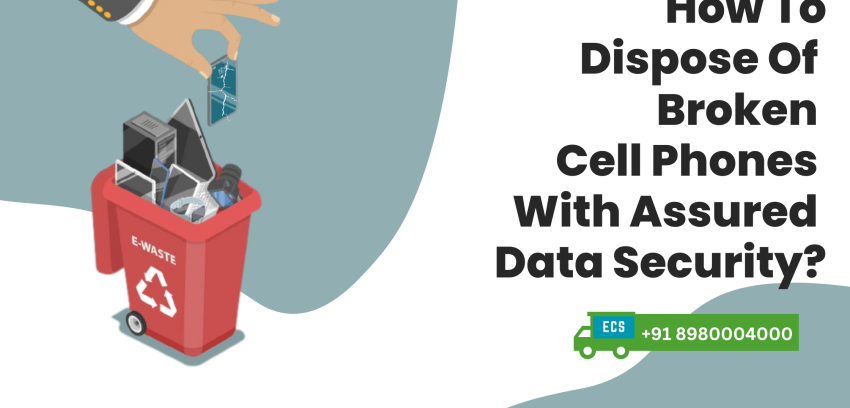TABLE OF CONTENTS
- The Risks of Incomplete Data Erasure in Modern Businesses
- Data Sanitization vs. Data Deletion: What’s the Difference?
- Methods of Data Sanitization and Their Effectiveness
- Why Data Remanence Poses a Hidden Security Threat?
- Best Practices to Achieve Permanent Data Destruction
- How to Evaluate a Data Sanitization Service Provider?
- ECS: Guaranteeing Secure and Compliant Data Sanitization
- Conclusion
- FAQs
In the digital age, information has emerged as the most precious asset of companies worldwide. A 2025 report indicated that more than 80%of organizations suffered from data breaches or unauthorized exposure to data, which shows the need for secure data management. With companies gathering enormous quantities of sensitive data, the issue of the safe disposal of outdated or unneeded data becomes significant.
Although data growth opens opportunities, this aspect poses serious threats, especially regarding data security. Poorly disposed of or deleted information results in breaches, regulatory fines, and loss of reputation. This renders data sanitization permanently and irreversibly destroys information, a crucial element of the data sanitization process and an organization’s cybersecurity strategy.
The Risks of Incomplete Data Erasure in Modern Businesses
The partial destruction of data is much more than a trifling error. Most organizations believe deleting files or format storage devices is enough to stop data recovery. Nevertheless, lost files are restored using special data sanitization services. It is devastating because of the effects of partially undertaken erasure:
Data Breaches
Customer data, financial records, and intellectual property are in the wrong hands. A single incidence alone can incur millions of fines and cleanup expenses.
Legal Fines
The existence of such regulatory laws as GDPR, CCPA, and HIPAA demands a strict approach to sensitive information. Lack of conformity with inappropriate data destruction in India may lead to heavy penalties.
Reputational Damage
The partners and customers are less interested if the business can’t manage the data security, affecting long-term profitability.
Internal Threat
Former employees retrieve deletion of data or insiders exploit it for their advantage.
Data Sanitization vs. Data Deletion: What’s the Difference?
Data Deletion means deleting file pointers in a storage system and files not shown to the users. Nevertheless, the raw data is stored in the storage medium until overwritten, i.e., it can be recovered.
Data Sanitization is the process of destroying data permanently so it cannot be recovered, by utilizing confirmed methods of data sanitization, so that it cannot be reconstituted. This involves overwriting, cryptographic deletion, or physical destruction of storage media.
Deletion is a temporary solution, whereas data sanitization methods assure the irreversibility, which is very important to organizations that deal with sensitive or regulated information.
Methods of Data Sanitization and Their Effectiveness
 Data sanitization is accomplished in many ways, and these methods have different levels of effectiveness based on the data medium and sensitivity of the information. Common techniques include:
Data sanitization is accomplished in many ways, and these methods have different levels of effectiveness based on the data medium and sensitivity of the information. Common techniques include:
1. Overwriting
It is a technique that entails the overwriting of already existing data multiple times. Although it works with hard drives, overwriting does not protect solid-state drives (SSDs) because wear-levelling algorithms spread data between memory cells.
2. Degaussing
Degaussing with the help of the powerful magnetic field makes magnetic storage devices like hard drives useless and essentially removes the information. It is ineffective with SSDs or optical media.
3. Physical Destruction
The storage devices are shredded or ground so the data cannot be reinstated. This method is common with the old or dangerous media, and needs proper management by ensuring proper environmental compliance.
4. Cryptographic Erasure
Data becomes inaccessible by encrypting the data and destroying the encryption key. This approach works well with cloud storage and SSDs, making overwriting less stable.
Why Data Remanence Poses a Hidden Security Threat?
Despite its efforts to destroy, the remnant of electronic data remains a hidden yet significant security threat. With the advanced recovery software of a data sanitization company, hackers can use residual data to obtain the victim’s personal information, such as personal identifiers, financial records, and trade secrets.
Organizations usually underestimate this risk because deleted files are unrecoverable. Nevertheless, information in the formatted drives, old backups, or even partially overwritten media is recovered using forensic data recovery methods.
To manage data remanence, rigorous data sanitization techniques and the industry standard must be followed, like NIST SP 800-88, which gives guidelines on media sanitization.
Best Practices to Achieve Permanent Data Destruction
Permanent data destruction is a multi-faceted task that needs policies, procedures, and technologies. The best practices that businesses can embrace are as follows:
1. Data Classification
Data are identified and classified according to sensitivity and regulatory requirements to identify the suitable data sanitization method.
2. Utilize Standardized Tools
Use certified and industry-proven data sanitization tools and hardware to comply with security requirements.
3. Document Processes
Conduct a thorough process from data destruction services in Hyderabad, for equipment eliminated, and validation documentation shown during audits.
4. Frequent Audits and Checks
When auditing, ensure that data sanitized cannot be recovered.
5. Employee Training
The employees should be trained to practice safe data storage and disposal to reduce human error.
How to Evaluate a Data Sanitization Service Provider?
The involvement of a professional data sanitization company helps simplify the data sanitization process, but necessary to select the correct partner. The main factors considered are:
Method Transparency
The data destruction services in Kolkata should describe their data sanitization techniques and how they apply various storage media.
Security Measures
Assess the provider’s security for devices in transport, handling, and destruction.
Audit and Reporting
The provider must present certificates of data sanitization services and specify the devices sanitized and the methods applied.
Reputation and Track Record
Considering past clients’ experience, particularly in data sanitization in Mumbai, ensure it is reliable and professional.
ECS: Guaranteeing Secure and Compliant Data Sanitization
ECS is the provider of end-to-end data sanitization services that provide a combination of high technology and regulatory compliance. Their solutions involve certified overwriting, degaussing, cryptographic erasure, and organization-specific physical destruction.
ECS offers in-depth reporting and certification for all the projects so that businesses can prove compliance and security responsibility. Concentrating on the reduction of risks related to the data remanence, ECS assists business enterprises to preserve sensitive data and ensure operational integrity in 2025 and beyond. They are safeguarding data and helping in their sustainability by destroying data in an environmentally responsible manner.
Conclusion
Nowadays, data is a valuable resource, and necessary to ensure that it will be destroyed permanently and without any changes. Unfinished erasure and residual data are a big risk to a business in terms of regulatory fines and reputational damage. Awareness of the difference between deletion and sanitization, certified data sanitization methods, and best practices will likely lessen these risks significantly.
Using a reputable service provider such as ECS gives organizations a sense of ease that the data sanitizing process is secure and compliant, and the data is forever secured.
FAQs
1. What is data remanence, and why is it threatening?
Data remanence is any remnant data that occurs after deletion or partial erasure. Advanced recovery tools can extract these remnants, which are a major security risk in case sensitive information is revealed.
2. What are the primary approaches to the sanitization of data?
Response is the most common responses are overwriting (removing data through discarding magnetic fields), degaussing (applying magnetic fields), cryptography erasure (removing encryption keys), and physical destruction (shredding or crushing of storage devices). The decision is based on the type of data and storage media.
3. How do businesses ensure that their information has been destroyed forever?
Businesses can check permanent destruction by checking certified data sanitization tools, asking data destruction services to provide a detailed audit to check, and by verifying them regularly. Regulatory compliance and audit-ready documentation (documentation and destruction certificates) are required.





